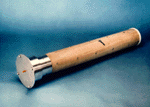 |
Of the six main instruments that will fly to Mars on Surveyor, the Mars Relay is the only one not designed to take scientific measurements. Instead, this cylindrical-shaped antenna will focus its efforts on collecting data transmitted to Surveyor from landers on the Martian surface. After collecting the data, Surveyor will transmit the data back to Earth. The advantage of using Surveyor as a relay satellite for Mars landers is that the lander spacecraft will not need to carry a large antenna to talk with the Earth. Instead, the reduction in the weight of the lander from not carrying a large antenna can be used for more scientific instruments.
The relay operates at a UHF frequency of 437.1 megaHertz and can listen to stations on the Martian surface up to 5,000 km (3,125 miles) away from Surveyor. In December 1999, NASA will use the relay antenna for the first time. That mission is scheduled to land a scientific package near the South Pole of Mars for a three-month study.
The Centre Nationale d'Estudies Spatiales in France provided the relay antenna to NASA as part of an international cooperation toward the study of Mars.